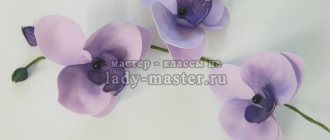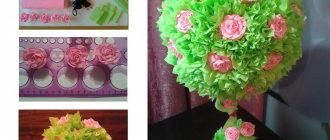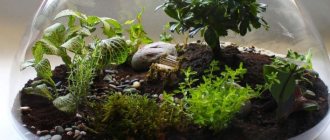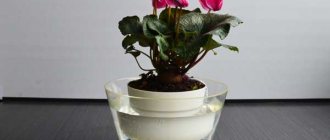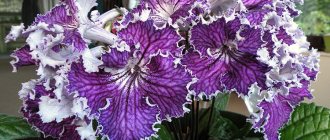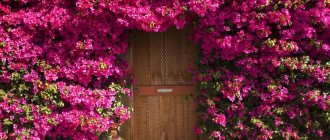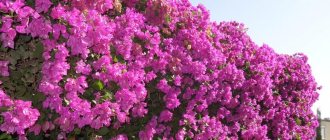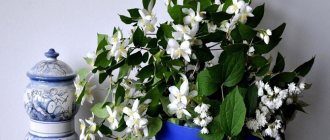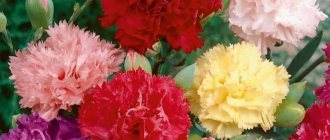Creepers are a favorite decorative material of florists. They decorate gazebos, decorate walls, and complement flower arrangements. One of them is hedera helix, a representative of the Araliaceae family.
Hedera helix is an evergreen vine. Homeland - Africa, southern Asia, southern Europe, Crimea. There its lashes reach 80 m. Thin and flexible, they wrap around supports: columns, balconies, fences. To do this, microscopic suckers and additional aerial roots on the stems are used.
Ivy hedera helix
Decorative properties are in the leaves. They are leathery and shiny. The color is dark green, which is why the plant is considered shade-loving. But the color of the leaves can be spotted and whitish. These varieties require more sun.
On vines that do not bear fruit, the leaves are 3- and 5-lobed. Those that bloom and bear fruit are ovoid or heart-shaped, without points.
You can grow ivy hedera mix at home. The poisonous properties of its berries are known. But they do not form on all types of common ivy, only on flowering varieties. But the hedera flower is inconspicuous - it is not favored by home gardeners. Therefore, to prevent the berries from ripening, the flowers are simply cut off.
For reference: in apartments, vines of this type grow 8-15 m in length. They beautifully wrap around partitions and curly stands.
Features of home care
Picture 2 Hedera helix mix.
Liana hedera requires careful care at home, in compliance with agrotechnical standards:
- Temperature. Liana doesn't like the heat. When it is above +20°C outside, the room is ventilated. The hedera indoor plant is not afraid of drafts and temperature changes.
- Lighting. The culture is shade-loving and grows well away from windows. Variegated varieties require a lot of light. But not a single type of plant can tolerate direct sunlight.
- Watering. Not a lot. Moisten when the soil has dried by 5-7 cm. In winter, the amount of moisture is reduced. In summer they water 2 times a week, in winter 1 time. Do not water at night because the water stagnates in the soil. Hedera tolerates drought better than overwatering - this is important for all lovers of indoor plants to know.
- Humidity. In winter, when the air is dried by heating, and in summer, the vine is sprayed. Use settled water. Humidity is kept within 35-40%. Twice a month, take a warm shower and wash off the dust from the leaves.
- The soil chosen is light and nutritious. Composition: turf and deciduous soil, peat, sand.
- Feeding. Mineral fertilizers are used: in the summer 2 times a month, in the winter they are reduced to once. Nitrogenous fertilizers in the spring, complex fertilizers in the summer, potassium compounds in the winter.
Virulence
The fruits of the plant cause a severe allergic reaction. Dizziness, nausea, and intestinal disorders appear. Berries cannot be eaten.
But the leaves and stems are medicinal and are used in folk medicine. Greens absorb staphylococci and influenza viruses.
Ivy in the country
The best shrubs and trees are always planted on a summer cottage. A climbing vine will decorate a place that is used for relaxation.
How to plant ivy on a plot
Many gardeners are interested in how to grow variegated garden ivy. It is better to plant cuttings in spring in breathable and nutritious soil to a depth of 15-20 cm.
Note! If the soil is heavy, you need to dig a hole a little deeper and make drainage from expanded clay or broken bricks. The young plant should be directed towards a support or fence
Watering is carried out moderately so that there is no stagnation of water. You can fertilize the vine with organic fertilizer once a month. Before winter, shoots should be covered to prevent frostbite of stems and roots.
The young plant should be directed towards a support or fence. Watering is carried out moderately so that there is no stagnation of water. You can fertilize the vine with organic fertilizer once a month. Before winter, shoots should be covered to prevent frostbite of the stems and roots.
Use in landscape design
Evergreen vines attract attention due to the variety of colors and shapes of the leaves. Designers use the plant to decorate vertical surfaces:. Note! When creating a structure, it is necessary to constantly direct the growing shoots in the right direction
Note! When creating a structure, it is necessary to constantly direct the growing shoots in the right direction
Combination with other plants
Common garden ivy can be combined with other plants that can embody any design ideas. The liana is planted near roses, flowering shrubs and coniferous trees. As a result, the gardener gets ivy climbing along the wall, which is pleasing to the eye.
How to prevent the growth of garden evergreen ivy
Gardeners are not always happy about the intensive growth of the plant, which begins to entwine nearby trees and bushes. To get rid of ivy, you need to cut it off at the very root, dig up the entire root system and make sure that there are no shoots left on the ground. Sometimes herbicides are used.
Following the rules of care, planting and propagation will allow you to achieve good results. Evergreen ivy will grow quickly and beautifully. With the help of the plant, they create an original landscape design, decorating hedges, other shrubs and even the walls of the house with greenery.
https://agronomu.com/bok/5976-osobennosti-razmnozheniya-plyuscha-cherenkami-i-otvodkami.html
https://greensotka.ru/dekorativno-listvennye/plyusch-sadoviy.html
Trimming
Pruning is a must for care. In spring, the vine is rejuvenated. The lashes are cut to 1/3 of the length, and the side shoots are shortened.
Golden scindapsus - home care
This is done so that the plant produces additional shoots and bushes. As a result, the ivy becomes dense. Then it is used as a basis in flower arrangements. When the branches are not given support and are planted in hanging flowerpots, the hedera becomes hanging.
For reference: cut branches can be stored for propagation, but you need to select the healthiest parts possible.
Hedera ampelous
Choosing a location and proper lighting
- Hedera requires a semi-shaded location. Sometimes a flower pot is even placed in the middle of the room, far from the window sills.
- Despite its love of shade, ivy needs sunlight to thrive in the home. Variegated species require more sun to keep the foliage attractive and vibrant in color.
- If hedera is grown as an hanging plant, then choose a wall well lit by the sun. The flower does not tolerate frequent changes of location; it is advisable to immediately select a permanent place for it.
How indoor ivy or hedera propagates
Hedera ampelous
Important! If exposed to direct sunlight, the young foliage of the plant can get burned. Hedera feels uncomfortable near heating appliances.
Reproduction
Bouvardia flower: home care and methods of propagation
Propagated in different ways:
- Cuttings. The apical shoots are cut and placed in water. A growth stimulator is added. You need to change the water and keep it there until roots appear. Then they are transplanted into the ground.
- Medium stem cuttings. To do this, cut a twig with 8-10 leaves from the middle of the vine. Make a groove in the sand, lay the cutting so that the leaves are on the outside, then water it. On day 10-12, roots will appear. The cuttings are dug up and cut, leaving a root and a leaf on each fragment. Planted in pots.
- By layering. A healthy stem is placed in a groove and sprinkled so that the top remains outside. When the roots appear, the cuttings are cut off from the mother bush.
- Seeds. They are collected or purchased. Sow on moist, compacted soil. Cover with glass. When sprouts appear, they are transplanted. It is difficult to care for them, the method is not rational.
Possible problems
The plant is little susceptible to disease. But pests may appear: aphids, mites, mealybugs. When they appear, hedera is treated with store-bought fungicides.
Other problems:
- brown dry edges of leaves - too hot;
- small leaves - not enough light;
- leaves lose color - cramped pot, not enough light;
- growth has slowed down - dry air.
Hedera erecta
Advantages and useful properties
The decorative hedera plant does not require any special treatment, so it is suitable for any room and will give it a refreshed look. Apartment, garden, gazebo or fence - ivy will take root everywhere. Even without a long absence of light, it will not die, since under natural conditions it grows on the lower tier of the forest and is always covered by tree crowns.
Due to the large number of long vines and leaves, indoor ivy helps purify the air and saturate it with oxygen. This is an advantage in modern urban conditions, when the air is stale and polluted with exhaust gases.
Another plus is its medicinal properties. For example, an alcohol tincture from the fruits of hedera keeps blood vessels toned and is useful for high blood pressure. Gels from the leaves have antibacterial properties and are used to treat purulent dermatoses.
Kinds
Hedera has 15 varieties of ivy for indoor cultivation.
Common varieties:
- An interesting plant is Hedera Erecta, an upright plant. Evergreen crop, reaches 90 cm in height. Frost-resistant, grows in pots or as an ornamental ground cover plant. Illumination - partial shade. Watering is average, soil acidity is also average. It grows slowly.
- Canary ivy. Originally from northern Africa. A fast-growing vine with a powerful stem. Covers the ground with a carpet, or rushes up the supports. The leaf is spotted.
- Colchis ivy. The creeping vine climbs to a height of up to 30 m. It has well-developed aerial roots and a powerful stem. The leaves are smooth and elastic. The shape is solid, size 25 cm in length.
Hedera liana is an ornamental plant that decorates houses, parks, and gardens. Easy to care for and loves partial shade. Easily braids pergolas, arches, walls, fences. Valued for its green mass. The flowers are inconspicuous, the berries are poisonous. Used in folk medicine - they make infusions for external use. Watering and fertilizing are moderate, rejuvenation is done annually. Transplantation - as needed. This plant will certainly be of interest to both beginners and professional gardeners.
Hedera is an evergreen vine from the Araliaceae family , very popular among lovers of indoor flowers. Perfectly decorates the interior and complements flower arrangements, used for landscaping walls and in flowerpots as an hanging plant. In this article we will talk about growing and caring for hedera at home.
Varieties of Hedera ivy
There are 15 species and about a hundred varieties of Hedera helix in the world. Most of the representatives of the genus are universal in their qualities and properties and can be grown both in open ground and indoors.
- Hedera canariensis - Canary ivy. Homeland - Portugal. Large-leaved variety without aerial roots. In its natural habitat it reaches 20-30 meters in length.
- Hedera helix "Goldheart". Belongs to the extensive Hedera chemical mix family. A variegated variety bred artificially. Large heart-shaped leaves with a whitish or yellowish central part. Goldhart is equally good at planting along walls for vertical gardening, and as a horizontal decoration for personal plots.
- Hedera helix "Hester". A rather rare variety with narrow long leaves, rarely growing more than 3 meters.
- Hedera helix Fatshedera lizei is the original result of crossing Fatsia japonica with Irish ivy. The Fatsheder hybrid retains its species characteristics only when propagated by root shoots.
- Hedera colchica - Colchis ivy. The leaf blade of Colchis ivy is considered the largest. An adult leaf grows up to 15 cm in diameter. The leaf length is 25-27 cm. Hedera colchica is the record holder for the longest flowering period. In the natural environment, flowering time begins in August and ends in late autumn.
- Hedera pastuchovii (Pastukhov's ivy). A rare variety listed in the Red Book. Unlike its brothers, it does not like rocks and stones - it prefers trees. The leaf is wedge-shaped, less often heart-shaped, no more than 9 cm in diameter.
- Hedera maderensis. Named after its homeland - the island of Madeira. Phytodesigners use one of the varieties of the variety, which has reddish-purple ellipsoidal leaves.
Is it possible to keep Hedera helix flower at home?
The length of hedera branches (Hedera helix) at home reaches 6-15 meters. The leaves are leathery, dense and glossy dark green or pinnate.
Although the plant is considered shade-tolerant, feathery ivy species require good lighting to maintain their decorative color.
The leaves, depending on the type of vine, have a three-, five- or seven-lobed shape.
Lianas bloom, if you keep them at home, extremely rarely with small, inexpressive, yellow-green flowers collected in an umbrella.
Hedera berries are small, black or yellow, poisonous.
How to keep ivy in an apartment:
Signs and superstitions
Some sources classify hedera as energy vampires. If conflicts often occur in the family, then ivy will absorb excess negative energy. However, if there is an atmosphere of kindness and positivity in the house, the flower will act in a similar way, it will begin to take away positive energy.
There are also good signs about the hedera flower:
- Wearing an ivy talisman brings health, beauty and prosperity;
- If one of the guests is jealous of you, then the flower neutralizes bad vibrations;
- It is recommended that it is useful to grow hedera in the work cabin, as it promotes career growth.
Perhaps you have had a loach growing in your apartment for a long time, just remember what atmosphere reigned in the family all this time? If you have been plagued by bad luck, try to get rid of the flower - maybe it was the one that was attracting trouble all this time. If, on the contrary, everything turned out well, continue to take good care of the loach. Perhaps he is the talisman of your home!
Tags: growing at home, transplanting, watering after purchase, reproduction, care
Lena Pavlova 05/22/2020
Growing and breeding hedera helix mix at home
Ivy propagation
Ivy is easy to propagate by cuttings, apical shoots, layering and seeds.
Cuttings and apical shoots
Hedera helix mix cuttings about 8 cm long with 2-4 internodes take root well. In order not to spoil the branches of the plant and to improve their branching, the tops of the shoots are cut off .
Cut branches are placed in water. After the roots appear, the plants are planted in pots and the tops are pinched to form branches.
Use ready-made soil or make it yourself by mixing humus, turf soil, peat and sand.
To make the plant more magnificent, several sprouts are planted in a pot and covered with a jar or plastic bag.
The sprouts are regularly ventilated and sprayed . During the first year, pinching is done repeatedly for better branching.
Medium stem cuttings
A stem cutting with 7-10 leaves is buried in a container with sand to a depth of 1.5-2 cm, leaving the leaves outside, and watered.
After 10 days, roots appear near the leaves, and the top of the stem begins to grow. The twig is taken out of the sand, divided into cuttings with one leaf and planted in pots.
To propagate by cuttings, cut off the tops of the shoots and place them in water until roots appear.
Seeds
This is the most time-consuming method . The purchased seeds are soaked for 2 days in a damp cloth. For fast and friendly germination, a growth regulator is added.
Small pots are filled with soil and seeds are planted in them. The temperature is maintained at 23-28°C.
The disadvantage of the seed propagation method is the possibility of splitting the variety.
By layering
Without cutting the branch from the mother plant, make a shallow longitudinal cut on it and attach it with a staple to the soil. The area with the cut is sprinkled with damp soil.
When the branch takes root, it is separated from the mother plant and transplanted into a separate pot.
Ivy propagates by cuttings, apical shoots, layering and seeds
How to grow ivy from seeds
Growing hedera from seeds is a troublesome task. Own seeds often do not ripen, and purchased ones are found without varietal characteristics.
- Seed material is soaked in growth stimulants: succinic acid and potassium or sodium humate. When using, you must follow the instructions.
- The seed is soaked in succinic acid (1 tablet per liter of water) for about a day; in a humate solution (a third of a teaspoon is diluted in 2 liters of water) - two.
- The seeds are dried and sown in a bowl, the bottom of which is covered with a drainage layer: expanded clay or broken brick.
- Pour the substrate, plant several seeds, keeping an interval of at least 10 cm between them. Buy the substrate in the store or prepare it yourself from garden soil and river sand.
- Cover the bowl with film or glass and place it in a warm place. To maintain a stable microclimate, the seedlings are not opened even for watering; the crops are moistened from a tray of water, which is installed under the pot.
Note. In a month the first shoots should appear. When they grow 2 true leaves, the seedlings are picked and transplanted into individual containers. Then the young seedlings are cared for like adult ivy.
Popular varieties of hedera
- Buttercup - pinnate leaves, a small part of them are pure yellow;
- White Night - white leaves with a rich green edge look unusual and attractive;
- Eva is the direct opposite of the White Night variety: green foliage with white edges;
- Glacier - distinguished by silvery spots on green foliage with white edging;
- Lacy - uniformly colored, rich green, lobed, three-fingered leaves;
- Peppermint Hummingbird - yellowish-cream spots on green foliage;
- Lusia ivy - light green foliage with dark green spots;
- Perkeo - rounded leaves.
Magnificent ivy and its types
Ivy or hedera in Latin is called Hedera helix, which means “climbing ivy.” The homeland of 15 plant species belonging to the genus Hedera is considered to be the subtropics of Europe, Africa and Asia.
In nature, these evergreen vines are accustomed to growing in the shade of tree crowns, which explains their ability to tolerate a lack of light.
An interesting feature of ivy is that the plant is unable to support the weight of its own leaves. Therefore, it sticks with its roots to any nearby surface, for example, a wall. To avoid this, you need to provide the ivy with support in the form of special bamboo or plastic sticks.
Due to the fact that, with good care, ivy grows long shoots, they can be used for interior decoration. Columns, arches or partitions entwined with flexible branches with beautifully shaped leaves create a special, refined coziness in the house.
The following types of hedera are most often grown in indoor floriculture:
- Common ivy (climbing);
- Canarian ivy;
- Fatsheder's ivy to Lise.
Common ivy (climbing) or Hedera helix is an unusually plastic plant, capable of attaching itself to even the slightest irregularities and entwining itself with any support in its path.
There are such popular varieties of this plant as:
- Annette with dark green leaves;
- Chicago with small bright green leaves;
- Chicago Variegata - yellow-cream border frames bright green leaves;
- Little Diamond with cream-veined leaves.
Canary ivy, called Hedera canariensis in Latin, is a species with larger leaves, often variegated in color, that is not able to cling to support on its own and needs to be tied up.
Its variety Gloire de Marengo is very popular with a combination of cream and green shades on the leaves.
Fatshedera Lizei ivy, whose Latin name is Fatshedera lizei, is a new hybrid that is very popular among gardeners, requires staking and grows up to 5 meters in height. A very beautiful variety called Variegata with white spots or a beige border.
Care
At first glance, caring for hedera is not difficult, but failure to comply with the maintenance conditions leads to the death of the plant, especially for novice gardeners.
Watering
Liana loves moisture , since the usual growing conditions for hedera are tropics and subtropics. The soil in the pot should always be moist, but the soil should not become acidic due to stagnant water.
When it gets colder, watering is reduced, and in winter it is reduced to a minimum. The soil should also not be allowed to dry out .
If the hedera overwinters at normal room temperature, water it as before.
Ivy loves moisture; when it gets cold, watering is reduced, and in winter it is reduced to a minimum.
Lighting and temperature
Ivy plants are considered shade-tolerant plants, but they feel more comfortable in good light. Pinnately-leaved varieties especially need it.
Direct sunlight should be avoided as it causes burns on the leaves.
Lianas are more comfortable in cool rooms : in the summer at +18°C, in the winter months - +12°C. In the summer season, vines are taken out onto loggias, balconies and terraces.
They are not afraid of sudden temperature changes and drafts. Dry air and high temperatures lead to scale insects.
Ivy loves good lighting, direct sunlight should be avoided
Humidity level
The liana is demanding on the level of air humidity . In hot weather, it must be regularly sprayed or the foliage wiped with a damp cloth.
It is not recommended to use special products to make leaves glossy.
Transfer
When the pot becomes too small, the plant is replanted . Signs that it’s time to replant ivy:
- no growth;
- wilting of leaves;
- roots peeking out of the pot's drainage hole.
Young plants are replanted annually, adult ivy - once every 2 or 3 years. It is preferable to replant in March-April.
The new container is taken 3 cm larger than the previous one . Drainage must be placed at the bottom of the pot.
Ivy transplantation:
Soil and fertilizing
The composition of the soil for ivy is not particularly important . A soil mixture for decorative deciduous indoor plants or one made independently from turf, humus, leaf soil, peat and sand is suitable.
The plant is responsive to root and foliar feeding. You can use fertilizers for decorative foliage plants.
In the warm season, fertilize every two weeks, in winter - no more than once a month . Excess fertilizer leads to yellowing of leaves.
Trimming
Pruning gives the heder splendor and improves its decorative effect . It is carried out in the spring, when intensive growth of the vine begins. Trimmed apical shoots are used for propagation.
Pruning and propagation of headers:
Difficulties of growing
Uneven watering, low air humidity and incorrectly selected feeding regime lead to a decrease in the decorativeness of ivy. You can determine which maintenance conditions are violated by the appearance of the plant. The main growing difficulties are summarized in the table.
Table - Problems when growing hedera
| Appearance of the plant | Main reasons | Help the plant |
| Indoor ivy dries, leaves turn brown | - Heat; - dry air; - irregular, poor watering; - pest damage | - Adjustment of detention conditions; - spray more often; - inspect for pests |
| Stems become bent, become bare, leaves become smaller | Insufficient lighting | - If possible, move to a brighter place; — organize additional lighting |
| Leaves turn yellow and wither | — Poor, irregular watering; - excess fertilizer | - In summer, water frequently and abundantly; - sprayed daily; — fertilizers are applied in accordance with the instructions for the preparation |
| The ends of the leaves dry out and turn brown | — Low air humidity; - heat; - dry soil | In hot weather, water and spray more often |
| The lower leaves are falling | Natural process | They don't do anything |
| Massive leaf fall begins | — Dry air; - appearance of pests; - rotting of the root system | - Increases humidity in the room; - spray ivy daily; — inspect for the presence of pests; - replant with pruning of damaged roots |
Diseases and pests
When kept in rooms with dry air, ivy can be attacked by scale insects and spider mites . Parasites can be removed by spraying with Karbofos at intervals of 3 days.
Treatment with a soap solution helps against aphids, and with insecticides against thrips.
A little work and compliance with all the subtleties of care will allow you to grow from a tiny cutting a magnificent plant that can turn any room into a corner of the summer garden.
Hedera is the optimal solution for those who are not ready to spend a lot of time taking care of indoor flowers. The second common name for the plant is indoor ivy. It is unpretentious and has many varieties. Currently, there are more than 15 species, differing in appearance and leaf size.
From temperature selection to transplantation
Hedera does not cause difficulties in care; it prefers to grow in summer at a temperature of 18 °C. In winter, 6-12 °C is enough for her. The lighting should not be too bright. This plant prefers partial shade, but there should not be a lack of natural light, as the bright color will fade. You cannot place a pot with a plant on the south windows.
The main conditions for growing are watering and humidity. Moisturizing should be plentiful, but the plant should not be flooded, as the leaves will begin to turn yellow and fall off. The humidity level during cool months should be moderate, but in hot weather and at temperatures above 20 °C, regular spraying is already required. Care should be organized so that the plant is comfortable and cozy. If you want to enjoy flowering, then a good neighbor for this decorative long-liver will be; you can plant them both at home and in the garden.
It is much more difficult to create the necessary winter coolness. It is imperative to reduce watering and place the pot in a bright but cool place. If this is not possible, then it is recommended to increase the air humidity. This will prevent pests from appearing.
Small hanging flowerpots or wall pots are used for growing, but in order for the vine to develop well, it must be constantly fertilized. This is done approximately 2-3 times in spring and summer, and in autumn and winter, feeding is reduced to 1 time per month. Growth continues all year round, but slows down in cold weather.
- humus;
- fine sand;
- turf in equal parts.
Ivy is most often propagated by apical cuttings; this process can be carried out throughout the year. The cuttings are cut and then rooted in water. prefers this too. The peculiarity of the vine is that it produces a large number of branches. To ensure this condition, shoots are periodically pinched.
Pests and diseases
Hedera is a plant that is not so capricious, but can be susceptible to various diseases. This is explained not only by violation of growing conditions, but also by the harmful effects of pests. You can detect damage from mites, scale insects, and thrips. Why is such a neighborhood harmful? The foliage begins to deform and then turn yellow. Control methods are extremely simple, you only need to spray the crown with insecticides; in rare cases, repeated actions are required, but usually the insects disappear quickly.
Decorative liana
Other diseases include:
- The leaves begin to turn yellow - this is a sign that there is too much water, while the ambient temperature is low. A similar phenomenon can be observed with a large amount of fertilizers.
- For mixed hedera and variegated species, a sufficient level of lighting is required. Lack of natural light causes foliage to fade and lose color.
- If the tips of the leaf blade become dry, this indicates the presence of dry air around at high growing temperatures. Watering in this case is also insufficient.
- If the branches have less foliage than usual, then this is a sign of poor lighting. Ivy can tolerate shade, but this does not mean that it likes these conditions.
- Small leaves and twisted stems occur due to lack of light. Another reason for this behavior may be a cramped pot. If you correct the listed errors, the plant will soon be transformed.
Hedera is a beautiful vine that many people grow at home. It adapts quickly, but still requires compliance with lighting and watering rules. If care is organized correctly, then ivy will delight you with its beautiful appearance for many years.
Hedera (ivy) is a type of evergreen vine that grows in the subtropical zones of Asia, Europe, and North America. Ivy is best used for landscaping vertical planes, creating a “living” surface. The plant has glossy leaves that are divided into several lobes (three, five or seven). Some species may have another type of leaves: oval or needle-shaped. Hedera flowers are small and not expressive.
Precautionary measures
Hedera is very poisonous. Its fruits, which look like greenish umbrellas, are especially dangerous. When taken orally in their pure form, they cause serious poisoning. Therefore, the plant should be kept where children and pets cannot reach it.
Important! Do not allow your pets to eat leaves of indoor ivy: this is likely to lead to death.
It is better to care for the plant by wearing rubber gloves. Particularly sensitive skin may develop an allergic rash if you trim the hedera or cut a stem from it with your bare hands.
Botanical description
The indoor ivy flower is a member of the Araliaceae family. According to various sources, the genus includes from six to 15 varieties. All of them grow mainly in mountainous areas - they use trees as supports and spread along the rocks.
Typical representatives of the genus are woody evergreen vines. They are fixed on the supports using special aerial roots that work like suction cups. As they grow, the stems thicken, become covered with bark, and turn into massive, uneven trunks.
The leaves are entire or three-five-lobed, depending on the variety. They are arranged alternately on the stem. Only mature plants over ten years old bloom. The flowers are small, yellow, with a greenish tint, collected in umbrella inflorescences. It is not possible to achieve flowering at home. The most common variety is hedera helix (common ivy).
There is a popular belief that hedera cannot be grown at home. Sometimes ivy is called “husband buster” - it is believed that the flower destroys marriages and forces a man to leave his family. But in Ancient Greece and Rome, ivy was a symbol of marital fidelity, and in the East - longevity. All signs associated with growing ivy at home are nothing more than superstitions.
